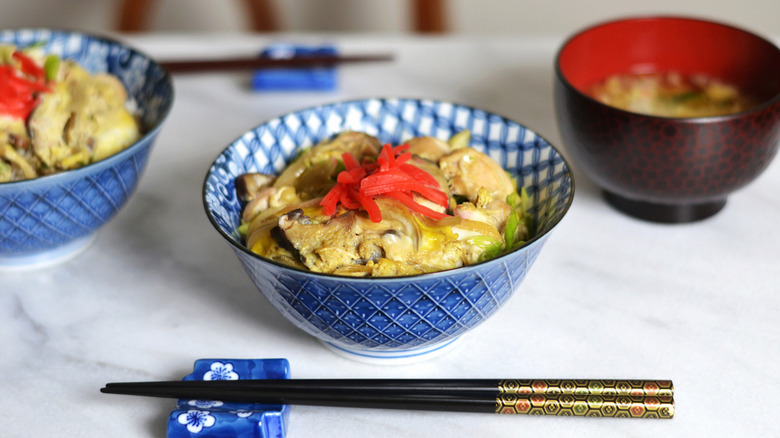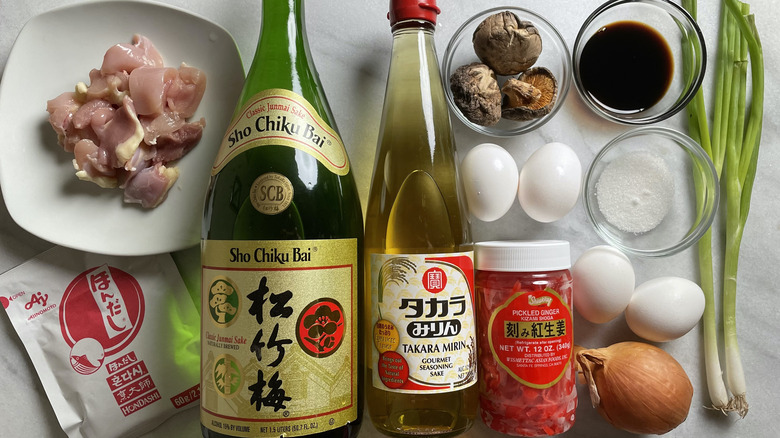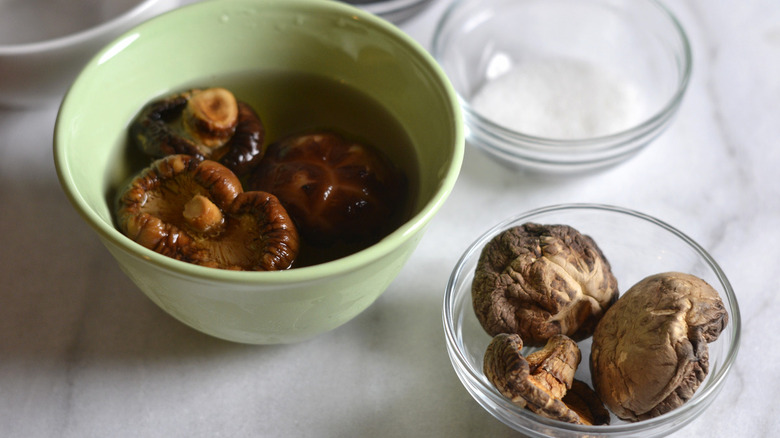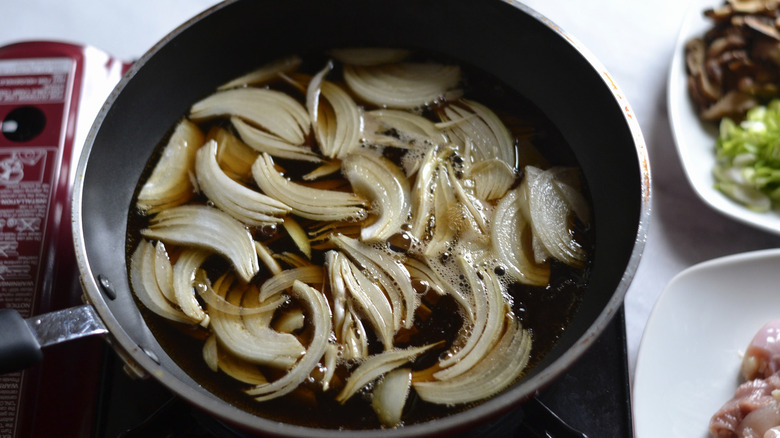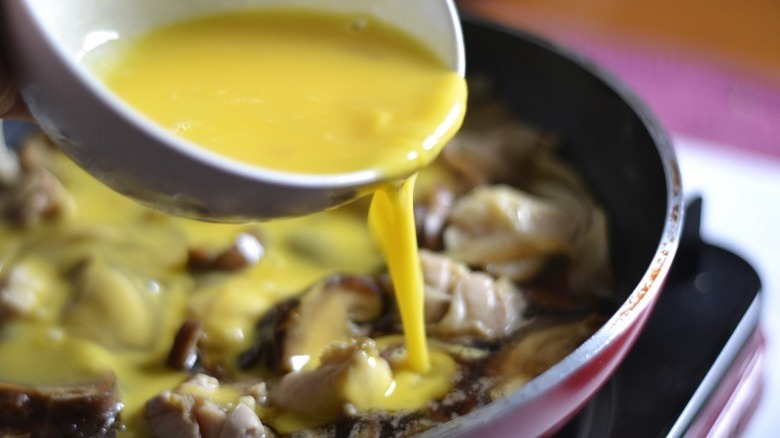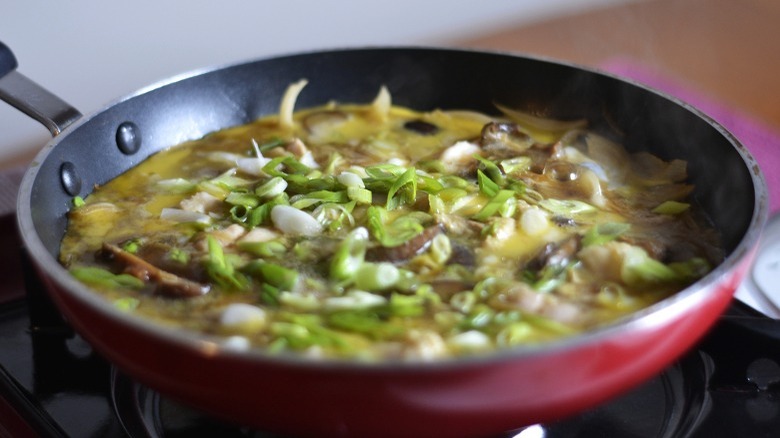Oyakodon (Chicken And Egg Rice Bowl) Recipe
Japanese chicken and egg rice bowls, also known as oyakodon, have culinary magic in every bite. While you can find these bowls pre-made at most Japanese grocery stores for a quick lunch, making them from scratch will ensure the freshest rice and most dynamic flavor. Approachable for all cooking levels, recipe developer Rika Hoffman has put together an authentic home-cooked Japanese oyakodon recipe guaranteed to impress all your senses (and guests).
"Oyakodon always includes chicken, egg, and onion," explains Hoffman. "Typically it is garnished with mitsuba, a leafy Japanese herb, but for accessibility, this recipe uses scallions." The special ingredient in this dish, she says, is dashi granules, which form a flavorful base for the chicken and egg. "Hondashi from the Ajinomoto brand is made to mimic the flavor of dried bonito," she adds. Also known as katsuobushi, bonito flakes are made from a relative of tuna. Now, pick up a few other Japanese pantry staples and get to oyakodonning.
Gather your oyakodon ingredients
Oyakodon is a deliciously flavorful dish thanks to several savory base ingredients, including dried shiitake mushrooms, soy sauce, and Hondashi (AKA dashi granules). A bit of cooking sake and mirin add more complexity to the foundation of the oyakodon, while sugar rounds things out with sweetness.
As for produce, you'll need a medium onion and a bundle of scallions. After picking up 4 eggs, a chicken thigh, and some short-grain Japanese rice, you're ready to cook. Of course, there is some room for variation if you can't find the exact ingredients.
If, for example, you don't have dried shiitake mushrooms on hand to make homemade shiitake dashi (which is simply the liquid leftover after soaking the dried mushrooms), Hoffman says to simply "use ⅔ cup of water instead and increase the dashi granules to ⅔ teaspoon. And if you don't like mushrooms, leave them out and increase the amount of chicken."
Make your shiitake dashi
Before you start cooking, you'll need to make your homemade shiitake dashi by soaking the dehydrated shiitake mushrooms in water for at least 6 hours. You can even start this the night before and simply place them in the fridge. Once they're rehydrated, squeeze the water from the mushrooms, saving ⅔ cup of the liquid for later. Combined with the Hondashi in the recipe, this shiitake-infused liquid gives the oyakodon "a more homemade taste," Hoffman says.
You'll also need to de-stem and slice up the shiitakes. While Hoffman says fresh shiitake mushrooms can work as a substitute, she recommends seeking out the dried variety because it "can be stretched and used two ways, yielding both dashi and plump mushrooms."
If you'd like to get other prep done in advance, you can also cook up some white rice if you plan to use the homemade stuff.
Cook your flavorful base sauce
Once your shiitake dashi is ready, it's time to create the flavorful foundation for your oyakodon. Combine the soy sauce, sake, mirin, sugar, Hondashi, and that ⅔ cup of shiitake dashi in a bowl. Add the mixture to a pan along with the sliced onion, then simmer for 2 minutes over medium heat.
Add the mushrooms, chicken, and eggs in batches
Before adding the eggs, you'll want to cook the chicken and mushrooms first. Add the bite-sized chicken and shiitakes to the pan and simmer for 3 minutes, until the meat is mostly cooked.
Next, beat the eggs and add about ⅔ of them to the pan, covering with a lid to cook for about a minute so the eggs become partially cooked. "In Japan, where eggs are safe to consume raw, many people prefer a softer-set texture," adds Hoffman. "How firm or jiggly you should cook the egg is totally up to personal preference." When the eggs are mostly set, add the rest of the beaten egg and simmer until they reach your desired level of doneness. Adding the eggs in 2 rounds, Hoffman explains, "gives more control over the final texture, especially if you prefer a creamier or softer-set egg."
Finish and serve your oyakodon
Top the egg and chicken mixture with plenty of scallions, serve over rice, and enjoy immediately. For extra pizzazz, Hoffman recommends Japanese red pickled ginger. Beni shoga's "punchy, acidic flavor brings liveliness to this classic Japanese comfort food," she says.
Oyakodon (Chicken and Egg Rice Bowl) Recipe
This Japanese recipe has everything you've ever wanted in a rice bowl: tender chicken, creamy eggs, and a deeply savory mushroom base.
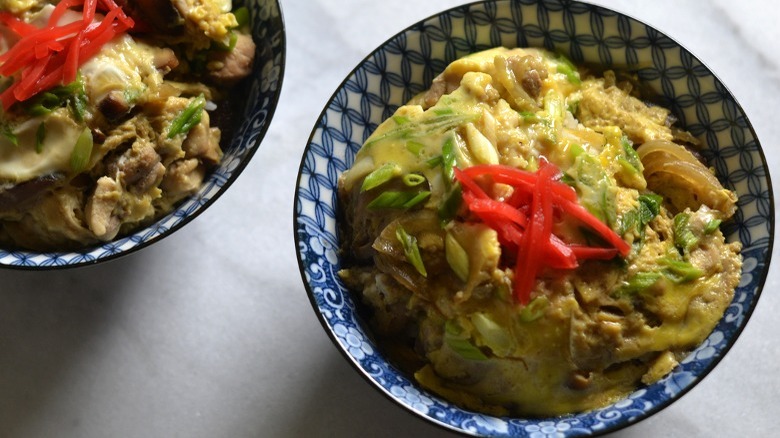
Ingredients
- 3 dried shiitake mushrooms, rehydrated, with ⅔ cup liquid reserved
- 2 tablespoons soy sauce
- 1 tablespoon cooking sake
- 2 tablespoons mirin
- 1 tablespoon sugar
- ½ teaspoon Hondashi (dashi granules)
- 1 medium onion or ½ large onion, sliced
- 1 chicken thigh, cut into bite-sized pieces
- 4 large eggs, beaten
- 2 scallions, sliced on a bias (or mitsuba, which is typically used in Japan)
- Cooked short-grain Japanese rice, for serving
Optional Ingredients
- Beni shoga (red pickled ginger), for serving
Directions
- Soak the dried shiitake mushrooms in cold water for at least 6 hours (or overnight in the refrigerator). Once rehydrated, reserve ⅔ cups of the soaking liquid, which is shiitake dashi. Next, squeeze the liquid from the mushrooms, remove the tough stems, and slice the caps into thin strips. Set aside.
- In a medium to large pan, combine the soy sauce, sake, mirin, sugar, Hondashi, and reserved shiitake dashi. Add the sliced onion and simmer for 2 minutes over medium heat.
- Add the mushrooms and chicken to the pan. Simmer for 3 minutes or until the chicken is mostly cooked through.
- Pour ⅔ of the beaten eggs into the chicken mixture and cover with a lid to cook for about a minute, or until the eggs are mostly set.
- Add in the remaining beaten egg, and top with scallions. Simmer until the eggs reach your desired level of doneness (from less cooked and very creamy to more cooked and set).
- Serve oyakodon over rice and top with beni shoga (red pickled ginger) if desired.
Nutrition
| Calories per Serving | 462 |
| Total Fat | 25.8 g |
| Saturated Fat | 7.5 g |
| Trans Fat | 0.1 g |
| Cholesterol | 466.6 mg |
| Total Carbohydrates | 19.6 g |
| Dietary Fiber | 2.1 g |
| Total Sugars | 9.5 g |
| Sodium | 1,104.2 mg |
| Protein | 31.3 g |
